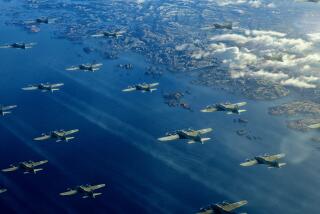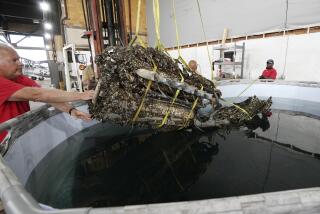From Lockheed’s Skunk Works Came Aircraft to Spy on World : Aviation: Burbank factory produced a series of planes that became among the most secret and significant of the 20th Century. Many historical functions are only now coming to light.
- Share via
If Stradivarius violins were airplanes, they would have been made at the Skunk Works, a little-known legacy of the Cold War that continues to evolve five years after the fall of the Berlin Wall.
From a small factory hidden inside a large corporation, a series of planes were developed that became some of the most secret, significant and revolutionary aircraft of the 20th Century.
“That amazing Skunk Works is unique in the world for producing secret airplanes far advanced beyond what was thought feasible and at a success rate that is simply extraordinary,” observed Zbigniew Brzezinski, former national security adviser under President Jimmy Carter.
The U-2 spy plane, the Mach 3-plus SR-71 Blackbird and the F-117 stealth fighter all were designed and built at the Lockheed Corp. Skunk Works, located then at the company’s sprawling Burbank plant.
During the chilliest years of the U.S.-Soviet face-off in the 1950s, about 90% of the military intelligence on Russia’s nuclear threat was gathered by the U-2, a pencil-thin jet that looked like a glider and sailed above missile range at an unprecedented 70,000 feet.
Former President Dwight D. Eisenhower considered the U-2 so vital to unlocking the secrets of the Soviet arsenal that he allowed the CIA to create its own spy plane fleet with pilots on loan from the Air Force.
“The fear was that the Russians were preparing a Pearl Harbor-style sneak attack,” said biographer Leo Janos, co-author of a new book titled “Skunk Works,” written with Ben Rich, the retired head of the secret factory.
“The truth is, we didn’t have a clue about what was going on behind the Iron Curtain,” Janos said in a recent interview. “We were on a fast track to oblivion if we didn’t solve this problem about knowing what the Russians were up to.”
Without the end of the Cold War, the historical function of the Skunk Works could not have been written about. Rich, 69, who retired four years ago, still is reticent, despite his pride in the accomplishments of the secret operation he ran for 15 years.
He began as a young engineer, working for the legendary designer Kelly Johnson, who built many of the century’s most famous planes, including the P-38 Lightning and the F-104 Starfighter.
“There’s a lot I can’t talk about, or I’d violate my classification,” Rich said in a telephone interview from his home in Oxnard.
The U-2 and its successor “black program” aircraft came to life in a warren of cramped shops and a World War II bomber hangar nestled next to the busy runways of the Hollywood-Burbank Airport.
A gifted team of engineers, pilots, toolmakers and assemblers labored under the “benevolent dictatorship” of Kelly Johnson. Johnson died in 1990, but his legacy of secrecy endures, even with the move of the Skunk Works 50 miles north to Palmdale in the Antelope Valley, where it is officially known as the Advanced Development Co.
Located just up the street from the Hollywood dream factories of Disney and Warner Bros., the original Skunk Works derived its name from Al Capp’s old Li’l Abner comic strip.
A foul smell that exuded from chemicals near the Lockheed facility prompted wags in the secret department to nickname it after a distillery depicted in the comic strip.
Skunk Works team members toiled in such secrecy that they could not talk about their work to their wives. They traveled in unmarked charter airplanes and checked into hotels on business trips using assumed names.
Keeping Soviet spies from unlocking the secrets of the Skunk Works was paramount.
“It was tough,” said Rich, who adopted the assumed identity Ben Dover, taken from the stage name of a London music hall entertainer. “There were a lot of divorces. If you had a strong marriage, it survived. If you didn’t, it broke up.”
Few Americans knew about the U-2 before the Russians shot one down carrying Francis Gary Powers on a spying flight over the then-Soviet Union. The incident aborted the 1960 summit between Eisenhower and Soviet leader Nikita Khrushchev.
A generation later, in an era of spy satellites, the glider-like plane is still carrying out reconnaissance flights where an eye-in-the-sky is needed. Spy planes have more flexibility than satellites because they don’t work in fixed orbits and can be sent where strategic planners want to peek.
Even before the U-2 incident in 1960, Johnson, Rich and the Skunk Works team were working on another spy plane: a revolutionary craft that could fly three times the speed of sound and so high it would defy any anti-aircraft missile.
Their dark dream was called the Blackbird, an ebony dagger of a plane that rolled out in 1964 and still holds the world records for speed and altitude, Mach 3-plus above 100,000 feet on the edge of space.
The Blackbird officially retired in 1990 after 26 years of secret service, roaming at will above the hostile skies of the former Soviet Union, Cuba, Nicaragua, North Korea, former North Vietnam and the nations of the Middle East.
When Kelly Johnson retired in 1975, he became a consultant, but left large shoes to fill in the small factory. Rich took over without knowing how he would extend the Skunk Works record for producing revolutionary aircraft.
In an irony of the Cold War, one of the greatest military technology breakthroughs for the United States arrived in the form of an obscure mathematical paper authored by a Soviet scientist. It was not even secret.
The Russian researcher’s theories about the diffusion of radio energy failed to interest the Soviet military complex, but they caught the eye of a radar specialist in Burbank, who brought his own wrinkle on the theory to Rich in 1975.
“As it happened, I was damned lucky,” Rich recounted in his book. “Stealth technology fell in my lap. I take credit for immediately recognizing the value of the gift I was handed before it became apparent to everyone else.”
The program that resulted was the most secret since the Manhattan Project, World War II’s crash development of the atomic bomb.
The F-117 stealth fighter that was invisible to radar remained a secret of the Pentagon for more than 10 years.
The stealth emerged from its cloak of secrecy at the end of the 1980s, in time to pulverize “high-value” strategic targets in Iraq during the Persian Gulf War, such as command and communication centers and nuclear targets.
Retired Gen. Lawrence Welch, former Air Force chief of staff, recounted: “We started with the stealth fighter program back in the ‘70s on the basis of a 20-minute presentation by Ben Rich and a hell of a lot of faith in him and his people at the Skunk Works. That faith paid off in Operation Desert Storm.”
The stealth and other programs swelled the Skunk Works coffers, and other secret programs continue, which Rich won’t discuss because of their classified nature.
Despite the loss of hundreds of thousands of jobs in California’s aerospace industry since the end of the Cold War, Rich remains confident that military aviation will advance and there will be people to fit the need.
“The door isn’t closed,” he said. “You can’t shut off your mind. As long as you have the mind and a computer, the only thing holding us up is affordability, so you have to be selective and do what is affordable.”
He said it’s difficult to forecast what a new Republican-held Congress will want, even though it cites defense as a high priority.
“The thing is in turmoil now,” he said. “The question is, what is their mood going to be?”
Rich said military innovators need to be working on weapons systems that disable communications and electronics instead of killing people, and he said he remains confident that experts can be found to do such work.
“We still have a lot of good industry in California--like Disney,” he said, brightly.
More to Read
Inside the business of entertainment
The Wide Shot brings you news, analysis and insights on everything from streaming wars to production — and what it all means for the future.
You may occasionally receive promotional content from the Los Angeles Times.










